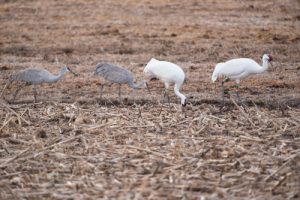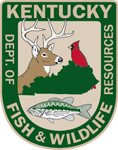 With sandhill crane hunting season opening the third weekend in December, the Kentucky Department of Fish and Wildlife Resources is issuing its annual advisory to hunters to watch out for federally protected whooping cranes.
With sandhill crane hunting season opening the third weekend in December, the Kentucky Department of Fish and Wildlife Resources is issuing its annual advisory to hunters to watch out for federally protected whooping cranes.
The whooping crane is an endangered bird that may not be hunted. The Eastern Population of whooping cranes migrates between Wisconsin and Florida, with their main migration corridor taking them through west-central Kentucky. There are 107 whooping cranes known in this population.
Wildlife biologists have confirmed the presence of six whooping cranes in Hopkins County. In previous years, whooping cranes have also been sighted in several other locations, including Barren County.
Kentucky’s sandhill crane hunting season begins Dec. 17 and continues through Jan. 15. The season will end sooner if the quota of 400 birds is taken prior to Jan. 15. Hunters who have applied for this quota hunt and been drawn to participate must successfully complete an online sandhill crane identification course before they can receive a permit.
Whooping cranes are solid white with black wingtips. They have a red crown. Adults may have a wingspan of 7½ feet and stand up to 5 feet tall on stilted legs. Juvenile birds are similar to the adults, but will have patches of brown or tan mixed in with the white.
Whooping cranes are similar in silhouette to sandhill cranes. However, sandhill cranes have gray bodies and are smaller than whooping cranes. Whooping cranes may associate with sandhill cranes so caution must be used while hunting sandhill cranes.
Hunters should always be sure of their target before firing a gun, regardless of the species being hunted.
Hunters who illegally transport deer or elk carcasses into Kentucky from states infected with chronic wasting disease (CWD) risk prosecution.
Hunters must not bring whole deer or elk carcasses from infected states to taxidermists or processing operations in Kentucky.
CWD is a contagious and fatal neurological disease that affects deer, elk and other cervids native to North America. Currently, there is no evidence that CWD can be transmitted to humans.
Chronic wasting disease has been detected in 24 states, including Ohio, Arkansas, Michigan, Missouri, Illinois, West Virginia, Virginia and Pennsylvania. The disease has also been found in the Canadian provinces of Alberta and Saskatchewan.
Kentucky, which does not have the disease in its animals, prohibits the importation of whole carcasses or high-risk cervid parts such as the brain, spinal cord, eyes, lymphoid tissue from deer or elk killed in CWD–infected states and provinces.
Hunters may bring back deboned meat, hindquarters, antlers attached to a clean skull plate, a clean skull, clean teeth, hides and finished taxidermy products. To help prevent the entry of CWD into the state, the Kentucky Department of Fish and Wildlife Resources discourages hunters from bringing back high-risk parts of deer or elk taken in any state, regardless of CWD status.
Several proactive steps have been taken by Kentucky Fish and Wildlife, the Kentucky Department of Agriculture and captive cervid owners to prevent the introduction of the disease into the state.
Kentucky Fish and Wildlife monitors wild deer and elk herds while the Kentucky Department of Agriculture monitors the captive herds. Since 2002, Kentucky has tested more than 26,000 deer and elk for the presence of the disease. All results have been negative.
Regulations enacted to reduce the likelihood of CWD in Kentucky have included a ban on importation of live cervids from CWD-positive states, mandatory CWD monitoring of captive herds and prohibiting the importation of high-risk carcass parts from CWD-positive states into Kentucky.
This disease can persist in the environment and may be contracted from contaminated soil or vegetation or through contact with infected cervid parts. The movement of live animals, either through the captive deer trade or natural migration, is one of the greatest risk factors in spreading the disease to new areas.
 Kentucky is participating in a three-state effort to test white-tailed deer for the presence of bovine tuberculosis.
Kentucky is participating in a three-state effort to test white-tailed deer for the presence of bovine tuberculosis.
While bovine tuberculosis (TB) is an infectious disease that primarily affects cattle, it also can infect deer. The disease has not been detected in Kentucky’s deer herd.
Wildlife officials in Kentucky, Indiana and Ohio recently launched a joint monitoring effort for the disease after an infected deer was discovered in southeastern Indiana. The Kentucky Department of Fish and Wildlife Resources will operate a check station in Boone County during the first two weekends of modern gun season for deer, Nov. 12-13 and Nov. 19-20, as part of that monitoring.
The department also will operate check stations in Bath, Nicholas and Fleming counties on those same weekends in a monitoring follow-up after the discovery of an infected cow in that area in 2010. Hunters will be asked to bring their deer by the check station so biologists can take tissue samples for testing.
Kentucky Fish and Wildlife Veterinarian Iga Stasiak said the state agencies intend to stop the disease from spreading further. “These efforts will help us determine whether or not bovine tuberculosis is present in our deer,” she said. “Participation in this effort may help ensure the long-term health and stability of wild deer populations in Kentucky.”
Testing will consist of collecting a few lymph nodes from the deer’s head. Hunters who wish to have their deer mounted can provide the name of the taxidermist so that arrangements can be made to collect samples from that location. The voluntary testing, which is designed to obtain samples from 500 deer from each of the two regions, is part of a joint monitoring effort by Kentucky Fish and Wildlife, the Indiana Department of Natural Resources and the Ohio Department of Natural Resources.
Kentucky’s check stations will be open from 8 a.m.-6 p.m. (Eastern) Nov 12-13, and during the same hours Nov 19-20. Locations include:
- Boone County: Boone County Cooperative Extension office, 6028 Camp Ernst Road, Burlington, Ky.
- Bath County: Bath County Cooperative Extension office, 2914 East U.S. 60, Owingsville, Ky.
- Nicholas County: Nicholas County Cooperative Extension office, 268 East Main St., Carlisle, Ky.
- Fleming County: Fleming County Cooperative Extension office, 1384 Elizaville Road, Flemingsburg, Ky.
Hunters outside of these areas can assist with the monitoring project as well. Hunters who see swollen lymph nodes, nodules in the lungs or chest cavity in any deer they are field dressing should report this to Kentucky Fish and Wildlife as soon as possible by calling 1-800-858-1549.
For more information, visit the bovine tuberculosis surveillance online site at http://fw.ky.gov/Wildlife/Pages/Bovine-Tuberculosis.aspx.
 Weather
Weather Traffic
Traffic @LouisvilleDispatch
@LouisvilleDispatch @LouisvilleDisp
@LouisvilleDisp Subscribe
Subscribe